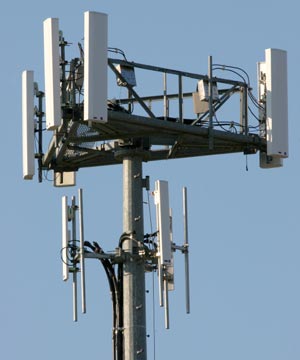Antenna Arrays (Phased Arrays)
|
An antenna array (often called a 'phased array') is a set of 2 or more antennas. The signals from the antennas are combined or processed in order to achieve improved performance over that of a single antenna. The antenna array can be used to:
To understand antenna arrays and phased arrays, navigate through the following pages: 1. Basic Concepts and Intro to Antenna Arrays
Antenna Array Basics
An antenna array is a set of N spatially separated antennas. The number of antennas in an array can be as small as 2, or as large as several thousand (as in the AN/FPS-85 Phased Array Radar Facility operated by U. S. Air Force). In general, the performance of an antenna array (for whatever application it is being used) increases with the number of antennas (elements) in the array; the drawback of course is the increased cost, size, and complexity. The following figures show some examples of antenna arrays.

Figure 1. Four-element microstrip antenna array (phased array).
Figure 2. Cell-tower Antenna Array. These Antenna Arrays are typically used in groups of 3 (2 receive antennas and 1 transmit antenna). The general form of an antenna array can be illustrated as in Figure 3. An origin and coordinate system are selected, and then the N elements are positioned, each at location given by:

The positions of the elements in the phased array are illustrated in the following Figure.
 Figure 3. Geometry of an arbitrary N element antenna array.
Let
 Figure 4. Weighting and summing of signals from the antennas to form the output in a Phased Array. The output of an antenna array can be written succinctly as:

This is what is going on in an antenna array. However, I haven't answered what the benefits of a phased array are. To understand what happens in an antenna array, navigate to the next section on Antenna Arrays.
Benefits of Antenna Arrays
To understand the benefits of antenna arrays, we will consider a set of 3-antennas located along
the z-axis, receiving a signal (plane wave or the desired information)
arriving from an angle relative to the z-axis of
 Figure 4. Example 3-element Antenna Array receiving a plane wave.
The antennas in the phased array are spaced one-half wavelength apart (centered at z=0). The E-field of the plane wave (assumed to have a constant amplitude everywhere) can be written as:

In the above, k is the wave vector, which specifies the variation of the phase as a function of position.
The (x,y) coordinates of each antenna is (0,0); only the z-coordinate changes for each antenna. Further, assuming that the antennas are isotropic sensors, the signal received from each antenna is proportional to the E-field at the antenna location. Hence, for antenna i, the received signal is:

The received signals are distinct by a complex phase factor, which depends on the antenna separations and the angle of arrival on the plane wave. If the signals are summed together, the result is:

The interesting thing is if the magnitude of Y is plotted versus
 Figure 5. Magnitude of the output as a function of the arrival angle for Antenna Array. Figure 5 shows that the phased array actually processes the signals better in some directions than others. For instance, the antenna array is most receptive when the angle of arrival is 90 degrees. In contrast, when the angle of arrival is 45 or 135 degrees, the antenna array has zero output power, no matter how much power is in the incident plane wave. In this manner, a directional radiation pattern is obtained even though the antennas were assumed to be isotropic. Even though this was shown for receiving antennas, due to reciprocity, the transmitting properties would be the same.
The value and utility of an antenna array lies in its ability to determine (or alter) the received or transmitted power
as a function of the arrival angle.
By choosing the weights and geometry of an antenna array properly, the phased array can be designed to cancel out energy from undesirable directions and receive energy most sensitively from other directions.
Before considering weight and geometry selection, we first turn to the fundamental function of antenna array theory, the Array Factor.
Up: Antenna Arrays Antenna Theory (Main Page)
This page on antenna arrays and phased arrays is copyrighted. No portion can be reproduced
except by permission from the author. Copyright antenna-theory.com, 2009-2013, antenna arrays, phased arrays.
|

 represent the output from antennas 1 thru N, respectively. The output from these
antennas are most often multiplied by a set of N weights -
represent the output from antennas 1 thru N, respectively. The output from these
antennas are most often multiplied by a set of N weights -
 - and added together as shown in Figure 4.
- and added together as shown in Figure 4. , as shown
in Figure 4.
, as shown
in Figure 4.